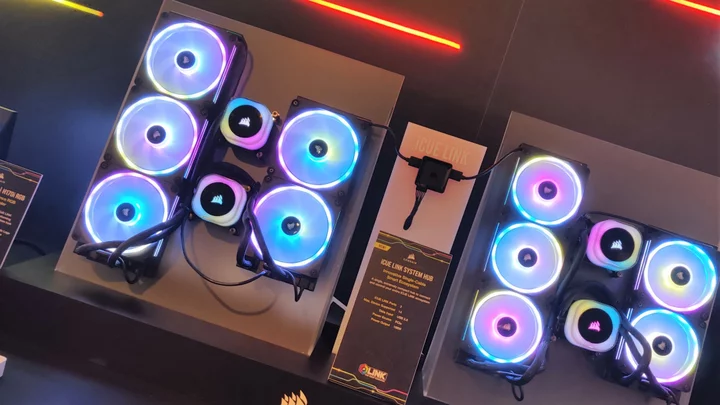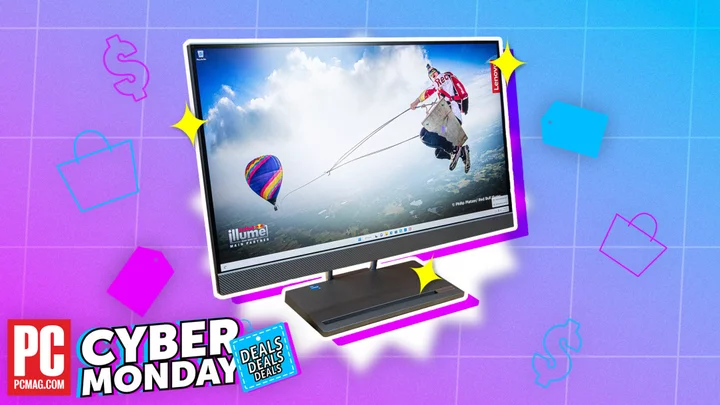We were especially looking forward to seeing Corsair’s suite at Computex 2023 because during CES 2023, we got a sneak peek at Corsair’s long-in-development iCUE Link hardware under wraps, and were eager to see more. We couldn’t talk about them back during CES, but the products are now likely to live in the wish lists of thousands of PC builders before and after their June 27th launch.
Reimagining System Lighting
The concept behind iCUE Link is simple: Make PC fans, coolers, and eventually other gear easy to connect in series. The goal is to eliminate the need for sprawling masses of cables that make cable routing a nightmare and the least favorite part of assembling a PC. If you can snap together a series of fans, connect that with a short cable to another series of fans, and have your CPU cooler in that chain somewhere, you can eliminate a lot of cable mess and only run cables where they really need to be.
That's Corsair’s aim for iCUE Link, and it now has a host of products that make use of this new design. Let’s take a look at some of Corsair’s new AIO coolers and fans to see how this design works.
As you can see in the photo, these RGB-capable fans do not have any cables hanging off of each them; ordinarily, you would have a PWM fan control cable and a separate RGB cable. Instead, they have special proprietary edge connectors that enable adjacent fans to snap together. This would apply for standalone case fans mounted in series, or for the fans on a 240mm or 360mm water cooler.
Then, with a group of side-by-side fans connected, you need to run only one cable from one of the fans and connect it to a Corsair iCUE Link System Hub, which works as a controller managing the fan speed and lights, or to more iCUE Link-compatible fans or coolers in a chain.
By doing this, you are able to easily mount and connect all of the fans together without the pain of afterward plugging in those fan-header cables and RGB LED cables to various headers on the motherboard or separate fan and/or RGB controllers. This makes the building process far easier, and you can do more with the iCUE Link to cool the whole system—not just the CPU. That's where this differs from the snap-together fan solutions we've seen from a few other vendors to date.
The iCUE Link System Hub has two connections for supporting AIO coolers and fans. Up to 14 devices can be supported for each iCUE Link System Hub, and, in theory, you could have more than one System Hub installed if you had even more fans. (Realistically, you’ll probably never have more fans and AIOs than that, but Corsair did have a sample system on display doing just that!) The iCUE Hub draws power from a PCIe 12VHPWR power connector and can handle up to 168 watts (W) of power. It also has a USB 2.0 header connection for communicating with the host system.
Using a variety of connectors, including some that work as splitters, you can connect close-by fans that aren’t able to directly connect to each other. This often happens with a single fan on the back of a case and one or more at the top of the case, and Corsair has clearly gamed out all the likely approaches in creating its accessory kits.
In addition to standalone fans and AIO coolers, Corsair has also introduced several other products that will be compatible with the iCUE Link system. Included in this are hybrid GPU water blocks, CPU water blocks, and pumps and reservoirs for custom-built water coolers. More will likely be announced closer to the June 27 release date, but the products we know of so far are as follows:
Corsair iCUE Link System Hub
Corsair iCUE Link H100i RGB, H150i RGB, H170i RGB AIO Water Cooler
Corsair iCUE Link H100i LCD, H150i LCD, H170i LCD AIO Water Cooler
Corsair iCUE Link H115i RGB AIO Water Cooler
Corsair iCUE Link Cable Kit
Corsair iCUE Link QX120 and QX 140 RGB Fans
Corsair iCUE Link XG3 RGB
Corsair iCUE Link XC7 RGB Elite
Corsair iCUE Link XD5 RGB Elite
Corsair iCUE Link XD5 RGB Elite LCD
The new iCUE Link-compatible gear will also play nice with any existing (non-Link) Corsair gear inside, all of which can be controlled via Corsair’s software. You just can't add those "legacy" Corsair items to an iCUE Link chain.
Potential Issues to Think About
Corsair’s new iCue Link technology is supremely interesting for casual PC builders, and, from the perspective of people who have built a lot of computers over the years, also a revelation. Having struggled to connect fan and LED headers in cramped cases for years, we don’t question for a moment that this is a better way of doing things. We’re especially glad that it does away with those extremely fragile and easy-to-break pins on RGB headers.
But that doesn’t mean we don’t see an issue or two with the design and room for improvement. First and foremost are concerns about motherboard compatibility. Typically, this is a nonexistent issue for fans, but if you’ve ever turned on a PC without a fan connected to the CPU fan header, you’ll know the system starts beeping at you like an R-rated movie edited for TV. You can ignore and sometimes even disable this in the BIOS settings, but not everyone is going to know how to do this or be comfortable with doing it. We'll have to see how this plays out in practice.
By far the easiest way to get around this problem (we'd think) would be to have a single 4-pin fan header going between the iCUE Link System Hub and the CPU fan header. This would introduce additional clutter and an extra cable, but we’d argue it’s a better solution than relying on end users to work around the issue themselves. It’s also far easier than getting all motherboard manufacturers to build in a workaround. We'll see!
The second issue is far less significant, but it comes from the power connection. Not many systems have a 12VHPWR connector, and even with an adapter, some don’t have extra PCIe connectors to spare for changing to 12VHPWR. We can’t help but wonder if powering the system off of one or two SATA power connectors might not have been a better option.
SATA power connectors can only support a maximum of 54 watts of power, which is a sizable drop from the 168 watts maximum supported by the iCUE Link system now, but realistically that’s overkill for most folks. It’s difficult to determine how much power is needed, especially on a modular system, but one customer support rep at Corsair told us that the max power draw of its 360mm iCue H150i Elite LCD XT Display Liquid CPU cooler (admittedly, not an iCUE Link product) was only about 15 watts. System builders often estimate about 5 watts per fan when calculating power usage, and the numbers provided by Corsair beat even that.
Things are never that simple, of course, and realistically we could see the 54-watt limit of a SATA power connector being problematic for the new iCUE Link system when it's taken to the limit. But two SATA connectors, possibly with an adapter, would increase this to 108 watts. That would be plenty in most cases, and realistically easier to accommodate with an existing power supply.
Don’t read too much into this, though, as Corsair’s decision to use the 12VHPWR connector may well prove to be the better option in the long run, as compatible power supplies proliferate. Especially if you are building a new PC, anyway, you likely will get a new PSU that supports what you need. And you can use an adapter with an existing PCI Express power connector if not.
Corsair’s new iCUE Link technology is exciting for all system builders, and we can’t wait for it to launch in late June. Pricing was not yet announced, but the reps we spoke with did say that it would be a "premium" solution. Each iCUE Link component contains additional circuitry for control and identification in the chain, which will add cost. Putting that aside, though: No RGB header and PWM cables? Priceless.









